Products for Anthraquinones
-
BCN8511
Physcion-8-O-beta-D-monoglucoside
Botanical source: The root and rhizome of Rheum palmatum L.(CAS NO.:26296-54-8)
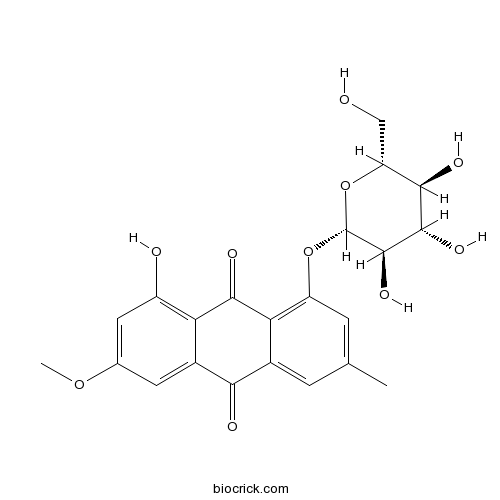
-
BCN2576
Aloin B
Aloin B is one isomer of Aloin; Aloin is a physiologically active anthraquinone present in aloe.(CAS NO.:28371-16-6)
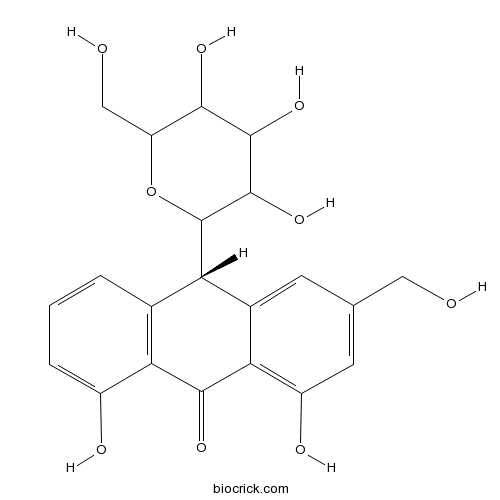
-
BCN1456
Aloe-emodin-8-O-beta-D-glucopyranoside
Aloe-emodin-8-O-β-D-glucopyranoside, a compound isolated from Saussrurea lappa, is a moderate inhibitor of human protein tyrosine phosphatase 1B (hPTP1B) with an IC50 of 26.6 μM.(CAS NO.:33037-46-6)
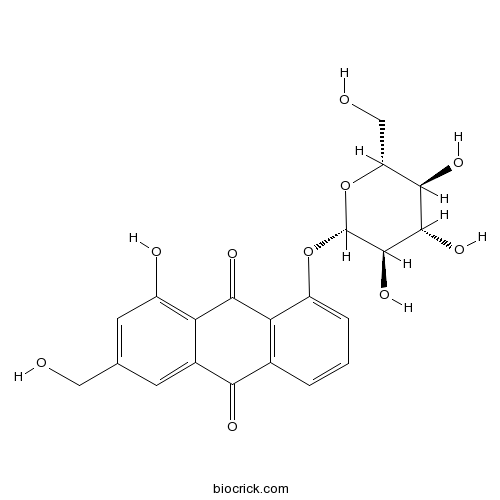
-
BCN7443
Questinol
Botanical source: The cultures of the fungus Talaromyces stipitatus KUFA 0207.(CAS NO.:35688-09-6)

-
BCN1004
Sennoside C
Sennoside C is an anthraquinone glycoside, found in leaves and pods of Senna (Cassia angustifolia).(CAS NO.:37271-16-2)
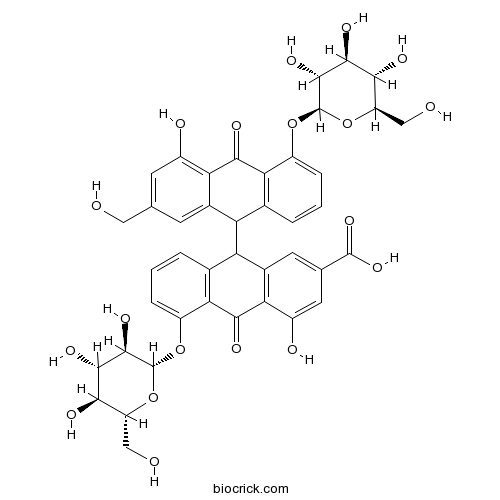
-
BCN1005
Sennoside D
Sennoside D is an anthraquinone glycoside, found in leaves and pods of Senna (Cassia angustifolia).(CAS NO.:37271-17-3)

-
BCN7446
Questin
Botanical source: The seeds of Cassia obtusifolia.(CAS NO.:3774-64-9)

-
BCN8512
Emodin-1-O-glucoside
Emodin-1-O-β-D-glucopyranoside, isolated from medicinal plant Polygonum cuspidatum Sieb. & Zucc, is a potent and noncompetitive bacterial neuraminidase (BNA) inhibitor with an IC50 of 0.85 μM.(CAS NO.:38840-23-2)

-
BCN5539
Damnacanthal
Damnacanthal is an anthraquinone isolated from the root of Morinda citrifolia. Damnacanthal is a highly potent, selective inhibitor of p56lck tyrosine kinase activity. Natural Damnacanthal inhibits p56 lck autophosphorylation and phosphorylation of exogenous substrates with IC50s of 46 nM and 220 nM, respectively. Damnacanthal is a potent inducer of apoptosis with anticancer activity. Damnacanthal also has antinociceptive, anti-inflammatory effects in mice and anti-fungal activity against Candida albicans.(CAS NO.:477-84-9)

-
BCN2537
Obtusifolin
Obtusifolin, isolated from the seeds of Cassia obtusifolia, regulates the gene expression and production of MUC5AC mucin in airway epithelial cells via inhibiting NF-kB pathway. Obtusifolin suppresses phthalate esters-induced breast cancer bone metastasis by targeting parathyroid hormone-related protein.(CAS NO.:477-85-0)
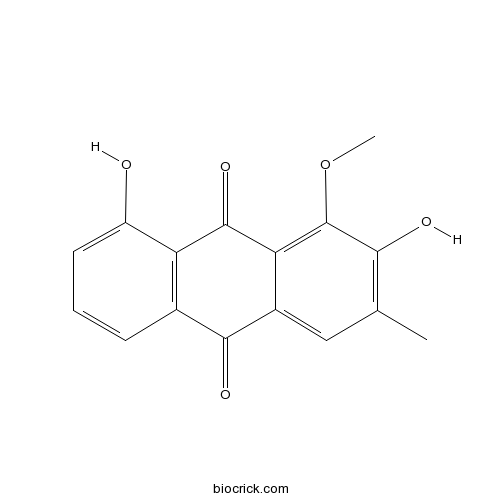
-
BCN3089
Digitolutein
Botanical source: (CAS NO.:477-86-1)

-
BCC1709
Lucidin
Lucidin (NSC 30546) is a natural component of Rubia tinctorum L. lucidin is mutagenic in bacteria and mammalian cells.(CAS NO.:478-08-0)
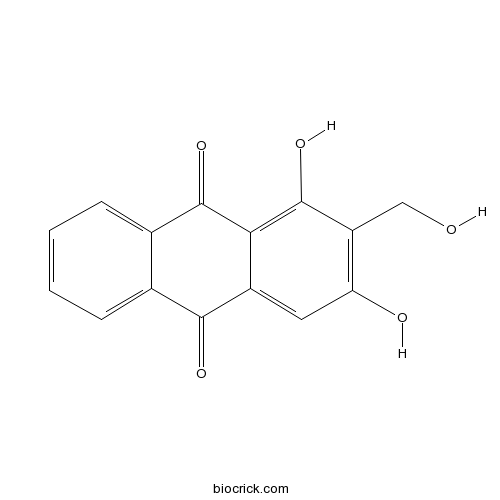
-
BCN5947
Rhein
Rhein is a lipophilic anthraquinone extensively found in medicinal herbs, and has many pharmacological effects, including epatoprotective, nephroprotective, anti-inflammatory, antioxidant, anticancer, and antimicrobial activities.(CAS NO.:478-43-3)

-
BCN5565
Aloeemodin
Aloe emodin is a hydroxyanthraquinone present in Aloe vera leaves, has a specific in vitro and in vivo antitumor activity.(CAS NO.:481-72-1)
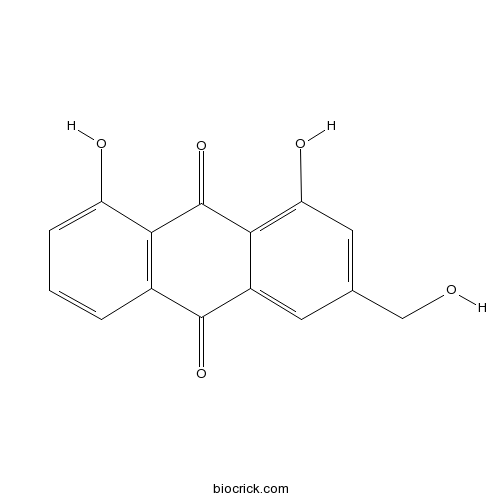
-
BCN5566
Citreorosein
Botanical source: The root and rhizome of Rheum palmatum L.(CAS NO.:481-73-2)

-
BCN5567
Chrysophanol
Chrysophanol (Chrysophanic acid) is a natural anthraquinone, which inhibits EGF-induced phosphorylation of EGFR and suppresses activation of AKT and mTOR/p70S6K.(CAS NO.:481-74-3)

-
BCC8146
Chrysophanol 1-glucoside
Chrysophanein is a chrysophanol glycoside from leaves and roots of Aloe hijazensis. Chrysophanein shows a moderate cytotoxic activity against several carcinoma cells lines.(CAS NO.:4839-60-5)

-
BCN6355
Sennidin B
Sennidin B, a stereoisomer isolated from the leaves of Cassia angustifolia, has lower activity than Sennidin A. Sennidin A inhibits HCV NS3 helicase, with an IC50 of 0.8 μM. Sennidin A induces phosphorylation of Akt and glucose transporter 4 (GLUT4) translocation. Sennidin A stimulates the glucose incorporation .(CAS NO.:517-44-2)

-
BCN5649
Emodin
Emodin is a broad-spectrum anticancer agent. Emodin inhibits casein kinase II (CKII) activity with IC50 of 2 μM.(CAS NO.:518-82-1)
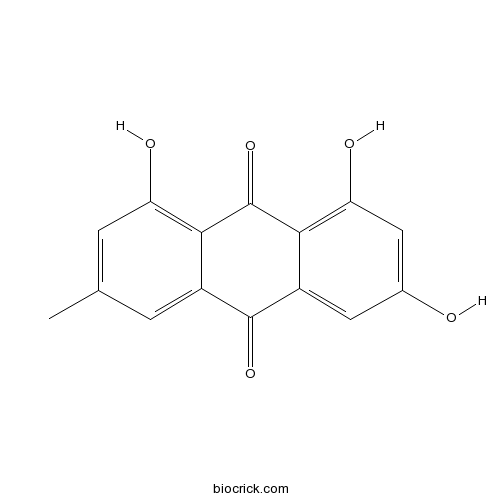
-
BCN6723
Xanthopurpurin
Botanical source: The roots of Rubia cordifolia(CAS NO.:518-83-2)

-
BCN5663
Physcion
Physcion (Parietin) is an anthraquinone isolated from traditional Chinese medicine Radix et Rhizoma Rhei, acts as an inhibitor of 6-phosphogluconate dehydrogenase, with an IC50 and a Kd of 38.5 μM and 26.0 μM, respectively. Physcion (Parietin) exhibits laxative, hepatoprotective, anti-inflammatory, anti-microbial, anti-proliferative and anti-tumor effects.(CAS NO.:521-61-9)

-
BCN2813
Protopseudohypericin
Botanical source: The herbs of Hypericum perforatum L.(CAS NO.:54328-09-5)

-
BCN5977
Hypericin
Hypericin is a photosensitive antiviral with anticancer and antidepressant agent derived from Hypericum perforatum.(CAS NO.:548-04-9)

-
BCN6348
Pseudohypericin
Pseudohypericin and its congener Hypericin are the major hydroxylated phenanthroperylenediones present in Hypericum species. Pseudohypericin shows anti-HIV activity.(CAS NO.:55954-61-5)

-
BCN7027
Averantin
Botanical source: The metabolites of Aspergillus sp. associated with Panax notoginseng.(CAS NO.:5803-62-3)






























